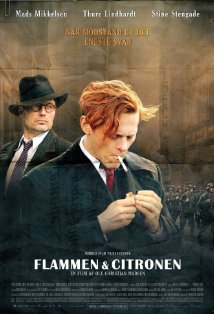Flame and Citron (2008)
by wjw on November 27, 2010
I caught this Danish film, based on the lives of two real-life Second World War Resistance heroes, thanks to Netflix. 
Since it’s based on real-life Resistance heroes, you know going in that this won’t be a happy film, because pretty much all the real-life Resistance heroes died. (Hey, I’m not telling you anything the original Danish audience didn’t already know.)
The story concerns two young Danes, Bent (called “Flame” for his red hair) and Jorgen (called “Citron” because he once sabotaged a Citroen factory). “They kill Nazis,” as Bonnie Parker might have said. They are in fact an assassination team who kill Danish collaborators. Flame does the shooting, and Citron is the driver— though eventually Citron is promoted to shooter as well.
They are extremely single-minded and dedicated. Citron’s left his wife and daughter in order to pursue his career as a killer, though the film suggests this may not have been as much a sacrifice for him as it is for his family. Flame has simply decided to kill Nazis until there are none left. (The historical record, though a bit murky, puts his total at something like 22.) He wears his red hair like Cyrano wore his panache, and hardly bothers to disguise himself despite the fact that his identity is known and the Gestapo have a reward for his capture.
One of the film’s few jokes involves their battered old car, and the fact that the local fire department repaints it after every mission. So whenever we see the car it’s a new color: red, blue, black, brown, powder blue.
The deadly duo are part of a much larger organization, the Holger Danske group, formed by veterans who had fought for Finland in the Winter War against the Soviets. Their section is headed by a high-powered lawyer named Winther, who surprises them by ordering them to kill some German officials— apparently the Germans don’t much care if their collaborators are whacked, but when a German is killed, they perform their usual excessive retaliation. Flame and Citron obey, but later receive information that Winther might be covering up his own pre-war dealings with these same Germans.
This information comes from Flame’s new girlfriend, who is one of Winther’s couriers but who also seems to have a cozy relationship with Hoffman, the head of the local Gestapo. Someone is playing somebody, but who?
The early parts of the film are shot in an almost documentary style. The shootings are almost matter-of-fact— Flame walks up to the victim, and then Bang!, it’s over— and the acting is underplayed in a not-quite-Jack Webb style. Which makes it more unfortunate when later scenes are overdramatized in more Hollywood fashion. When Flame has SS chief Hoffman trapped in a back room, Hoffman buys time with the old, “We are so alike, you and I” argument. My guess is that the real-life Flame would have had very little patience with this proposition, and just walked in and shot the bastard.
Flame and Citron have some perfectly astounding adventures in this film, and by far the more astounding seem to be true.
They die, of course. Heroically. After the war they’re dug up and given a huge state funeral. But the person who betrayed them collected the reward from the SS and lived happily for another fifty years. Which is just the way things go, isn’t it?
One of the things I rather like about this film is the plot elements aren’t tidied up— they stay complex and confusing, the way they are in real life. We never find out what Winther is really up to, we’re never certain of the relationships between some of the major players. We only know how they affect our heroes, how they lead to bad decisions and desperate acts and the eventual betrayal of the protagonists.
Rate this one four Lugers, but only if depressing true history is your thing.
(By the way, did you know that Poul Anderson was a Danish resistance hero? Though probably not the Poul Anderson you’re thinking of.)

Another Poul Anderson connection: the hero of _Three Hearts and Three Lions_, whose alleged name is Holger Danske and who starts his adventures as a Resistance fighter in Danemark.
Poul Anderson was very aware of his roots and his ancestry. Heck… he even looked Danish. Compare his pictures to pictures of Danish artist Kim Larsen (which I also think of has having a typical Danish face).
– Steinar (Norwegian)
Comments on this entry are closed.